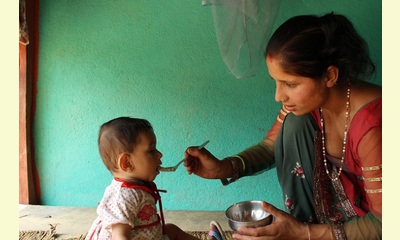|
|
Now Is the Time to Tackle Malnutrition and Its Massive Human Costs
un article par José Graziano da Silva, FAO Director-General and Margaret Chan, WHO Director-General.- for the Inter Press Service (Reprinted by permission)
The scourge of malnutrition affects the most
vulnerable in society, and it hurts most in the
earliest stages of life. Today, more than 800
million people are chronically hungry, about 11
percent of the global population. 
Sadhana Ghimire, 23, makes sure to give her 18-month-old daughter nutritious food, such as porridge containing grains and pulses, in order to prevent stunting. Credit: Mallika Aryal/IPS
click on photo to enlarge
Undernutrition is the underlying cause of almost
half of all child deaths, and a quarter of living
children are stunted due to inadequate nutrition.
Micronutrient deficiencies – due to diets lacking in
vitamins and minerals, also known as “hidden
hunger” – affects two billion people.
Our food systems are simply not sustainable or
healthy today, let alone in 2050, when we will have
to feed more than nine billion people. We need to
produce more food but also nutritious food and to
do so in ways that safeguard the capacity of
future generations to feed themselves.
Another worrying form of malnutrition – obesity –
is on the rise. More than 500 million adults are
obese as a result of diets containing excess fat,
sugars and salt.
This exposes people to a greater risk of
noncommunicable diseases – like heart disease,
stroke, diabetes and cancer – now the top causes
of death in the world. Poor diet and physical
inactivity also account for 10 percent of the global
burden of disease.
Many developing countries now face multiple
burdens of malnutrition, with people living in the
same communities – sometimes even the same
households – suffering from undernutrition, hidden
hunger and obesity.
These numbers are shocking and must serve as a
global call to action.
Besides the terrible human suffering, unhealthy
diets also have a detrimental impact on the ability
of countries to develop and prosper – the cost of
malnutrition, in all its forms, is estimated between
four and five percent of global GDP.
Government leaders, scientists, nutritionists,
farmers, civil society and private sector
representatives from around the world will gather
in Rome from Nov. 19 to 21 for the Second
International Conference on Nutrition (ICN2). It is
an opportunity they cannot afford to miss: making
peoples’ right to a healthy diet a global reality.
Current food systems are unsustainable and
unhealthy
Creating healthy and sustainable food systems is
key to overcoming malnutrition in all its forms –
from hunger to obesity.
Food production has tripled since 1945, while
average food availability per person has risen by
only 40 percent. Our food systems have
succeeded in increasing production, however, this
has come at a high environmental cost and has
not been enough to end hunger.
Meanwhile, food systems have continued to
evolve with an even greater proportion of food
being processed and traded, leading to greater
availability of foods with high energy, fats, sugars
and salt.
Our food systems are simply not sustainable or
healthy today, let alone in 2050, when we will have
to feed more than nine billion people. We need to
produce more food but also nutritious food and to
do so in ways that safeguard the capacity of
future generations to feed themselves.
(This article is continued in the discussionboard)
|








|
DISCUSSION
Il n'y pas encore de question liée à cet article.
* * * * *
Commentaire le plus récent:
(The following is continued from the main article listed above.)
Put simply: we need healthy and sustainable food systems – that produce the right balance of foods, in sufficient quantity and quality, and that is accessible to all – if we want to lead healthy, productive and sustainable lives.
In preparation for ICN2, countries have agreed to a Political Declaration and a Framework for Action on nutrition containing concrete recommendations to develop coherent public policies in agriculture, trade, social protection, education and health that promote healthy diets and better nutrition at all stages of life.
The Framework for Action gives governments a plan for developing and implementing national policies and investments throughout the food chain to ensure healthy, diverse and balanced diets for all.
This can include strengthening local food production and processing, especially by family farmers and small-scale producers, and linking it to school meals; reducing fat, sugars and salt in processed food; having schools and other public institutions offer healthy diets; protecting children from marketing of unhealthy foods and drinks; and allowing people to make informed choices regarding what they eat.
While government health, agriculture, and education ministries should take the lead, this task includes all involved in producing, distributing and selling food.
The ICN2 Framework for Action also suggests greater investments to guarantee universal access to effective nutrition interventions, such as protection, promotion and support of breastfeeding, and increasing nutrients available to mothers.
Countries can start implementing these actions now. The first step is to establish national nutrition targets to implement already agreed-upon global targets, as set out in the Framework for Action. ICN2 is the time and place to make these commitments.
FAO and WHO are ready to assist countries in this effort. By transforming commitment into action and cooperating more effectively with one another and with other stakeholders, the world has a real chance of ending the multiple burdens of malnutrition in all its forms within a generation.
(Thank you to Janet Hudgins, the CPNN reporter for this article.)

|
|









